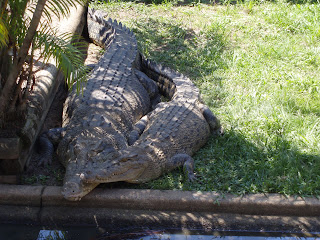Thursday 15th September
Darwin is a very hot place, though at present it is a very dry heat. We have spent our time dodging from one patch of shade to the next.
Not having yet been threatened by a crocodile, Paul was filled by the urge to see one, so we decided to go to something that described itself as a crocodile park and zoo. As it is some way outside Darwin, we went on the bus.
I must say buses in Darwin are wonderful. $2 is sufficient to allow you to ride any number of bus anywhere for 3 hours - you can change bus as many times as you like within the three hours. And they seem to run exactly to time. Interestingly enough, those we have used have not been at all full, and other passengers have mostly been schoolchildren, pensioners and Aboriginal people. I suppose it is likely that most people in Darwin have cars - certainly there are an awful lot of car showrooms in the city, for both new and second hand cars.
We were interested in the trip out of the city, as it soon became clear how dry the countryside was. What grass we could see was short and bleached to a sort of beige colour. In many places though, there was just bare red earth and the occasional tree.
The crocodile park was, in fact, a crocodile farm, and I am far from certain I would have gone had I known that beforehand. Many of the crocodiles we saw were destined to become handbags, and their meat is sold as steaks, sausages or burgers.
However, the guide who took us round said that crocodile farms were ensuring the survival of crocodiles, since they were not now suffering from poaching. There was no need for handbag makers to buy poached skins when they could buy farmed ones so cheaply. Moreover, farmers now welcomed crocodiles on their land, since they were paid $100 for each crocodile egg - and the eggs were collected by the crocodile farmers, not the landowners. The result of this was that crocodiles were no longer endangered - their numbers, which had dropped to as few as 5000 during the 1970s, were now in the hundreds of thousands.
The farmed crocodiles were grown up to about 2 metres (around 5 years old) and then killed for the skins, which were sent away to be tanned. However, we also saw some of the biggest crocodiles I have ever seen in my life - some must have been nearly 20 feet long.
These were mostly ones which had been removed from Darwin harbour, and were part of the captive breeding programme. They were paired with a female, and the eggs were taken and put in an incubator so that all would hatch safely. Some looked quite content.
However, there was one miserable enormous one with his jaws wired shut because he had bitten his wife. They were waiting to see if he continued to attack her, or if he had learned that domestic violence did not pay. If he continued to attack her, he might be given a bigger, stronger wife in the hopes she would bite him back.
We also saw the smaller (2 meters) crocodiles jump out of the water to catch some meat. It certainly cures you of any desire to go near the water!
At the end of the tour, we all had the chance to hold a baby crocodile. I found it quite sweet, it was warm with a very soft skin, and it listened to me most carefully when I spoke kindly to it. Of course, it might not have listened so carefully had its jaws not been taped shut!
We had a brief look at some of the other animals in the zoo part. I photographed some rather depressed looking turtles, who swam around us, obviously hoping we would do something interesting.
I don't think I've ever been so close to ostriches. I only managed a photo of Mrs. Ostrich, who I was hoping wouldn't peck me - she was much taller than her fence. I failed to photograph Mr Ostrich, who was seeing off some Japanese tourists, and I found it too hot in the sun to wait for him to come back.
The emu was having a dust bath, and the cassowary just looked cross. The male dingo was pacing nervously, and the red kangaroo came to see if we had anything to give him, and appeared disappointed that we had not.
The monkeys were in cages with very thick bars, and we felt they would have been happier in the freedom of Singapore Zoo. The ocelot was curled up asleep behind a tree, and the lions had found a place in the shade at the back of their cage to sleep. The tiger had, apparently, been removed.
We had a brief lunch and a look at the crocodile museum, then caught the bus back and spent some time cooling off in our air-conditioned room.
In the evening, we headed off to the night market and ate our supper at one of the stalls there.






No comments:
Post a Comment